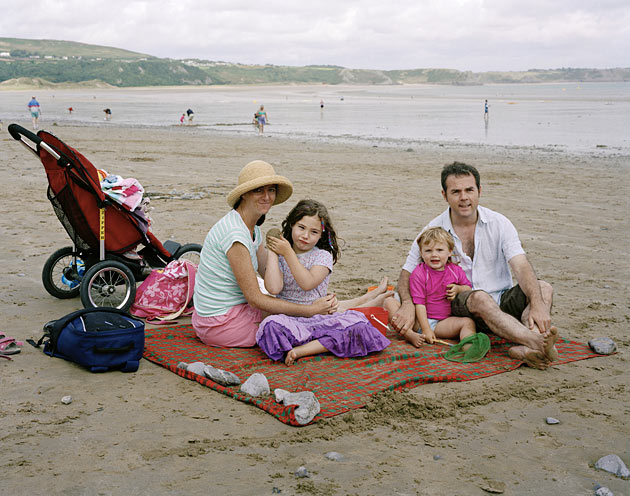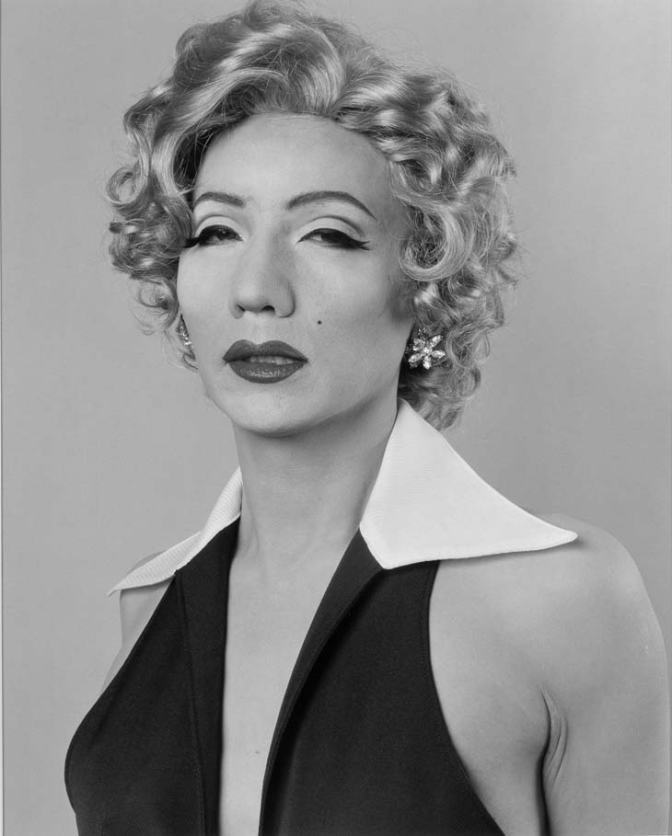Of all the self portrait work discussed to date, the idea of masquerades really caught my interest and I have spent some time reading about and looking at the images of the artists referenced in the text. I have also followed further references and considered the work of several other artists who are working in this area. I will start by saying something about this work and then draw together my thoughts and learning from reviewing this work.
Nikki Seung -Hee Lee
Nikki S. Lee (b 1970) is a Korean born photography who based in New York but now works in Seoul whose work takes the notion of the artist as the subject to an all together different dimension than the artists i have written about earlier in this section. Indeed considering her work I have to ask myself is she a photographer or performance artist with the latter winning out. Her approach is to assume the identity of different characters, dressing up as them and then playing their role in the world at large. In this work she takes on both the individual identity of the character she is playing, but also participates in the group identity in which her character would exist. She then asks an onlooker to make an image. The work includes her playing the role of a tourist, someone at a wedding, a jogger and a bride. One of the edgiest and most risky , by her own admission was playing the role of an exotic dance. I was also struck by the idea of paradox and irony in some of the work, like the image below where she is a character in this image?

Copyright Nikk Sueng-Hee Lee
Her work explores identity at a number of levels and not just from the characters point of view but also from the group perspective. There is something about the exploration of subculture and the images reveal more than just the character she is assuming. This work and the ideas behind it appealed to my interest in culture and the social construction of meaning. The performance nature of Lee’s work demonstrates the power of an image beyond a conventional story telling narrative and offers some insight into decoding ideas about the post modern narrative. Boothroyd (2015) suggests that Lee’s work questions the reliability of the photograph as a record. My view is that this has always been in question, what Lee does for me is raise questions about how a fictional narrative might reveal trust in the way a pure record of an event might not. in this sense the idea of documentary photography is challenged. I am also reminded of the reading earlier in the program about authorship and the death of the author. I will return to this themes later in my conclusions
Trish Morrissey
Trish Morrisey (b1967) is an Irish born artists who has also explored the idea of identity through constructed scenes and images. She has done this through a novel and confident approach. In her work front (front referring to the sea front, although to me its alternative colloquial meaning of cheeky confidence also perhaps applies to her approach) she visited beaches around England and also in Australia ( while she had a residency there). Approaching family groups on the beach she requested that she swopped clothes with the main female figure in the family group and replaced them in a fictional scene that is then photographed by the person she has replaced. This must have taken some nerve and I can only imagine her level of self confidence. The images are strangely beguiling and there is strong sense of smooth ng natural but also unnerving. She is simulation and gust and interloper, a cuckoo in the nest, literally. Like Nikki S. Lee, she forms part of a wider seen although she is perhaps more obvious in the scene because she is not as disguised as Lee is in her work. As well as exploring identity this work considers boundaries and to me asks questions about a families dynamics and relationships. The work is simultaneously engaging and a bit disturbing. Also like Lee’s work it rises questions about authorship and perhaps shed light on a postmodern narrative in which meaning is created through thinking about the fiction it creates. Cotton (2014) suggests that this type of approach:
‘rather than being evidence of the photographs originality (or lack of it) or statement of authorial intention, photographs were seen as signs that acquired their significance of value from their place within a larger system of social and cultural coding”
pp191
This really helpful statement leads me to ask about the family photograph and its importance and meaning. The images with Morrissey as the interloper or imposter, still have a strong sense of the family group to the viewer that doesn’t know the family in the picture and are still valid examples of that trope. I think it is this that made this work so attractive to me. there is a cultural coding built into this type of image because they are so much part of family life. Morris test this coding by replacing a key element but the code rains as strong as ever.

Copyright Trish Morrissey
Yasumasa Morimura
Working in this similar genre of mascara ad and mimicry the Japanese born artist Yasumasa Morimura (b1951) has created a series of self portraits that parody western art. His eastern eye brings a critical outsiders view and I am uncertain of there is a degree of mockery as part of his mmimicary. Cotton (2014) refers to his experiments with the malleability of identity and this can be seen in his portraits. It is however the overt parody that stands out to me in this work . The image below perhaps typifies the point I am trying to make. Mimicking an american icon, Murimura as Marilyn Monroe is both parody and humour. The image is clearly not Monroe, but it has features of Monroeness’, that are recognisable, beacusue Monroe is such an icon, her lines has become a recognisable cultural code. , Murimura is playing this back to the viewer. There is fiction and truth in the image

Copyright Yasumasa Morimura
Cindy Sherman
In researching the genre of the self portraiture in photography Cindy Sherman’s (b 1954) name is a recurrent theme. Sherman has used herself as the object for her work over many projects. Her series of self portraits that were based upon and inspired by moments from american cinema attest the the iconography of american cinema and how these have passed into a common cultural awareness. Replicating scene from cinema, Sherman captures something of time and culture. At the same time the images can be larger than life with an extreme empathise on makeup and features. There is something of parody rather than homage. Cotton (2014) suggests that Sherman’s work, Untitletled Film Stills is:
a demonstration of the argument advanced by feminist theory the ‘femininity’is a construction of cultural codes and not a quality that is naturally inherent or essential to women.
pp193
With this in mind Sherman’s self portraits far from being studies of different selves are far more about how society assigns attributes based upon appearance, gender and culture. This opens a new and interesting area to consider the value of the image as a representation of how culture is constructed and not just a story narrative.
Final thoughts
It’s is hard to summarise the learning from considering masquerades, but what I can say is that my ideas about the purpose and nature of images and their meaning has been expanded. Through replication and mimicry all of the above artists are commenting not just on culture and identity but also how the visual codes create wider understanding.
There are also some interesting ideas about authorship in this work and I am reminded about the earlier coursework about the death of the author and the post modern non linear narrative. In all of these works the artists have constructed the images but they not the photographer. Or are they? Questions are raised about who is the photographer. In a modernist critique it is perhaps the person pushing the shutter release, not so in a postmodern interpretation.
All of the artist above have something to say about intent being beyond the domain of the photographer too. There is something beyond the contents of the from of the image that purposefully allows the viewer considerable latitude in their interpretaion of the image. These are examples of a postmodern critique and a postmodern view of photography as a medium. I am of course merely scratching the surface of what feels more like an exploration of the construction of meaning in the world about us than it does an interpretation of images. I will need to reflect more upon this, but this is very different territory to the ideas I wrote about when considering documentary narratives!
References
Boothroyd, S. (2015) Context and Narrative, Open College of the Arts, Barnsley
Cotton, C. (2014) The Photograph as Contemporary Art, Thames and Hudson, London
Kino, C. (2006) Now in Moving Pictures: The Multitudes of Nikki S. Lee, New York Times found at: http://www.nytimes.com/2006/10/01/arts/design/01kino.html?ex=1317355200&en=ba68cca87c7383c1&ei=5088&partner=rssnyt&emc=rss&_r=0 (Accessed October 2016)
Nikki S. Lee: The Creators Project found at: https://www.youtube.com/watch?v=oI8xpJItPVI (Accessed October 2016)
Phillips, S. (2013) Trish Morrissey’s best photograph: infiltrating a family on a Kent beach, Guardian, found at:http://www.theguardian.com/artanddesign/2013/jan/23/trish-morrissey-best-shot (Accessed October 2016)
Morimura-Yasumasa found at: http://www.britannica.com/biography/Morimura-Yasumasa (Accessed October 2016)